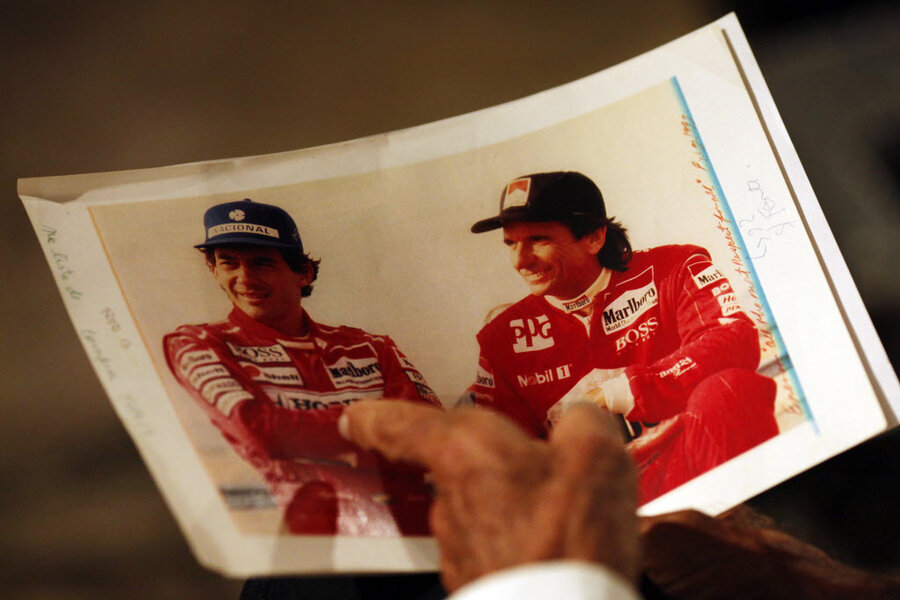Ayrton Senna remembered 20 years after his death
Loading...
| Rome
It is a testament to Ayrton Senna's lasting impact on Formula One that the 20th anniversary of his death will be observed this week with five days of commemorations at the Imola track where he had his fatal accident.
ItalyCurrent and past F1 drivers, mechanics, racing officials and fans will pay their respects to Senna and Austrian driver Roland Ratzenberger, who also died at the 1994 San Marino Grand Prix.
"When I was a kid I had all the books, all the videos, (Senna) was the driver I looked up to, way before I even started racing," Mercedes driver Lewis Hamilton said shortly before winning the Chinese Grand Prix eight days ago. "He kind of inspired me to even be a driver."
Hamilton was 9 at the time of Senna's death.
"It was very difficult for several days to really (accept) your hero's gone," the British driver said.
Senna was a hero to many and is often voted as the greatest F1 driver in history.
He won three Formula One titles — in 1988, 1990 and '91 — all with McLaren. He moved to the Williams team for his tragic 1994 season. Despite his career being cut short when he was 34, his 41 wins stand third all-time behind Michael Schumacher's 91 and rival Alain Prost's 51.
Beyond the numbers, Senna attracted legions of followers for his humbleness and strong Catholic faith.
"He was loved to an unbelievable degree," said Mauro Forghieri, a former car designer for Ferrari and other F1 teams, who was called on as an expert witness in the court trial following Senna's death.
Forghieri recounted how when Senna's coffin was transported back to his native Brazil, it wasn't put in the airplane's luggage hold but rather placed over three rows of the first-class cabin.
"Of course the airline and the pilot were Brazilian," Forghieri told The Associated Press in an interview. "He was considered much more important than a president."
The Brazilian government declared three days of national mourning for Senna and an estimated 3 million people lined the streets as his coffin was driven into his hometown of Sao Paulo.
"It's one of those things, couple of events in your life that happen where you exactly remember where you've been, what you've done," said four-time defending F1 champion Sebastian Vettel, who was 6 when Senna died. "I remember that I was watching television with my father and obviously as a child you don't really understand what's going on, but just by the reaction of my father, I obviously got to understand that it was very serious and a big loss for Formula One.
"I think only later on and probably the last couple years, I managed to understand how big the loss was for the sport because I got to work with people that used to know him, (and work) with him," Vettel added. "He was the reason why my father decided to follow Formula One."
For anyone watching, the 1994 San Marino GP was truly a disaster.
Senna died after crashing into a concrete wall at about 300 kph (186 mph) in Sunday's race. Another high-speed crash in Saturday's qualifying killed Ratzenberger, a rookie.
On Friday, the car of Rubens Barrichello went airborne, crashed against the barriers and flipped. The young Brazilian sustained a concussion and amnesia and called his survival a miracle.
Senna had been shocked by Ratzenberger's death and refused to complete qualifying Saturday.
On Sunday, shortly after the race restarted following five laps at slow speed behind the pace car after another crash that injured four spectators, Senna'sWilliams Renault car went straight through the Tamburello turn, a spot with a history of bad accidents.
Senna was transported to a hospital in nearby Bologna and was declared dead four hours later.
"For the people who were there and experienced them, they were three days that will never be forgotten," Forghieri said.
The Italian judicial system debated the cause of Senna's death for more than 10 years, with a probe that led to manslaughter charges against the Williams team's technical director, Patrick Head, and former designer Adrian Newey, for a faulty steering column. They were eventually cleared when the statute of limitations had run out.
The attention around Senna's death brought about safety improvements at the Imola track and throughout F1, resulting in shorter straights, more room around dangerous turns and less powerful engines.
After a memorial mass on pit lane at the Imola track on Wednesday, Forghieri and others will discuss the evolution of safety in F1 at a symposium on Thursday — the exact anniversary of Senna's death on May 1, 1994.
There will also be a memorial football match in Imola, a charity dinner, Kart races and other activities.
The San Marino GP was last run in 2006 before F1 expanded into new markets in Asia and the Middle East, but memories of Senna live on an area of Italy that is known as the cradle of auto racing.
Associated Press writer Justin Bergman in Shanghai contributed to this report.







